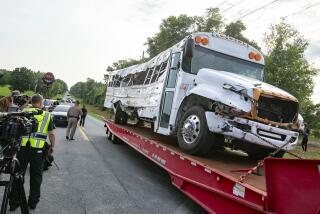Pakistanis Try to Deal With Aftershocks
For survivors of the earthquake-ravaged north squatting in an unfinished government apartment complex here, the terror that struck Oct. 8 replays itself dozens of times each day in their new surroundings.
More than 800 aftershocks have rocked Islamabad, the Pakistani capital, and nearby Rawalpindi since the magnitude 7.6 temblor estimated to have killed nearly 80,000 and rendered 3 million homeless.
“I sleep outside at night,” Sitara Jabin, 60, says, because of the aftershocks that send the rest of the newly arrived fleeing the nearly completed four-story brick and cinderblock structure.
The quake has shaken more than the immediate environs of its epicenter near Muzaffarabad, where many of the town’s 600,000 people are now among the nomadic homeless.
Before Oct. 8, Islamabad and Rawalpindi were not regarded as high-risk areas for seismic events, but they are now believed to lie along a fault line that had not been identified as active. More than four million people live in the two cities.
“We knew the boundaries of the tectonic plates but because there was no history of such seismic activity in this area, it wasn’t rated as high risk,” Qamar-uz-Zaman Chaudhry, head of the Defense Ministry’s Meteorological Department, said of the 80-mile stretch between the capital and the hardest-hit areas to the north.
The department’s seismologists have embarked on an urgent remapping of the country’s seismic zones, he said. Muzaffarabad is to be reclassified as a high-risk area, and possibly Islamabad as well.
“Islamabad will be more vulnerable than previously thought,” Chaudhry said. A $3-million remapping project was undertaken after last December’s Asian tsunami, and if the capital is redefined as a Category I, or very high hazard area, “there will be very major consequences” for future development, he said.
Civil engineers and city planners are already revising building standards. New structures will have to be able to withstand at least a magnitude 8 quake and existing high-rises must be retrofitted, said Kamran Lashari, director of the Capital Development Authority, the government agency that oversees construction in Islamabad.
“We are now very rudely shaken to this new reality and are taking a new look at our entire building methodology,” Lashari said. “People here are now questioning the very existence of high-rise buildings.”
One 10-story building in the 148-unit Margalla Towers complex collapsed in the quake, undermining confidence in the structural integrity of the capital’s apartment blocks and government structures. At least 74 people died and 88 were injured.
Lawyers for the occupants contend that the builders used substandard materials and made gross deviations from approved construction plans.
Other structures in Islamabad, including the Parliamentary Lodges that house legislators, also suffered severe damage that compelled residents to evacuate. The Capital Development Authority has received more than 250 urgent requests for structural inspection, Lashari said.
Amid concerns about Islamabad’s seismic vulnerability, authorities have decided not to permanently accommodate some of those displaced from the north. Tens of thousands have flocked to Islamabad and Rawalpindi to seek shelter with family or to be closer to the front of the aid pipeline. Tent cities have sprouted on government land, as well as in parks, sports fields and parking lots.
“It cannot be said that it is safe here either,” said Sardar Mahmood, head of the volunteer Bali Foundation caring for 350 patients at a makeshift hospital at the Jinnah Stadium. “Everyone discharged from here is given a tent, blankets, food and clothing and sent back north.”
Many who fled the quake ruins say they want to return to their northern towns and villages if they are provided adequate shelter to survive the approaching Himalayan winter.
“We don’t feel safe here. We run out when there are aftershocks,” said Khurshad Gilani, who along with 17 other extended family members on Wednesday broke into a ground-floor apartment of the unfinished G-6 government housing complex.
“There’s no electricity. No water. We want to go back [to Muzaffarabad] as soon as we can get a roof over our heads.”
Relief agencies’ efforts to house quake survivors in their own environs have been hampered by a shortage of winterized tents.
Gilani expects to spend the winter here but hopes to return north in the spring and begin rebuilding his shattered home.
No formal decision was made to move quake refugees into the 240-unit G-6 housing complex, which is near completion but unoccupied due to intra-governmental squabbling. But authorities have signaled their acceptance of the takeover by delivering relief goods and parking a water tanker nearby. Plastic sacks filled with cereal, canned milk and cartons of juice are stashed along the walls of the apartments, empty but for the survivors’ few salvaged possessions. Aid agencies have given stacks of blankets and cheap carpets to cover the bare tile floors.
In neighboring Rawalpindi, the gritty town from which Islamabad was launched in 1962 when the capital was moved from Karachi, thousands of quake survivors have set up camp in sports fields, market squares and on the lawns of military buildings.
“There’s nothing left for us back there,” Mohammed Karim said of his home in the village of Hattian. Like many searching for shelter in Rawalpindi, he and two dozen family members hired a bus to bring them here to reunite with injured relatives evacuated by helicopter for treatment.
Jabina Ali, consoling a wailing infant on her shoulder, recounted how she and three dozen relatives, after spending two nights without shelter, had jumped onto the emptied truck beds of an aid convoy leaving Muzaffarabad.
They are now camped out in a crude lean-to on the grass outside the Murree-Rawalpindi Mini-Sports Complex, a refuge that reminds her too often that the temblor also struck here.
“It’s like living through the earthquake again and again,” she said of the aftershocks that routinely measure more than 5 on the Richter scale.
“Sleeping on the ground, you really feel them. It’s horrible. I can’t live like this much longer,” she said.
Those charged with providing for the influx of survivors are just as eager to see them return home.
“We are telling them that the sooner they get home, the sooner their lives will be back to normal,” said Malik Shoaib, a district official in Rawalpindi.
Outside the army polo grounds, a huge relief staging area has emerged, with huge square awnings covering mounds of bedding, cartons of food, stacks of tents and rolls of plastic sheeting.
“People are coming here because this is where the aid is concentrated. But the shelters here are only temporary,” said Maj. Ahmed Khan Zubair, directing traffic among shipments of goods coming in from the nearby international airport.
“We’ve had such large seismic activities in the last days. We have to be concerned about the security of structures here as well,” he said of the government’s policy of dissuading quake victims from staying.
“We are morally obliged to take care of them. But as soon as shelter is available in their home towns, they will be encouraged to go back and I think most will be more than willing.”
More to Read
Start your day right
Sign up for Essential California for news, features and recommendations from the L.A. Times and beyond in your inbox six days a week.
You may occasionally receive promotional content from the Los Angeles Times.







